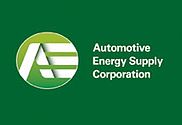Automotive Energy Supply
| Automotive Energy Supply
|
|
|---|---|
| legal form |
Kabushiki kaisha (joint stock company) |
| founding | April 2007 |
| Seat |
|
| management | Shōichi Matsumoto, President |
| Branch | Automotive industry chemical engineering |
| Website | www.eco-aesc-lb.com |
The Automotive Energy Supply KK ( Jap. オートモーティブエナジーサプライ株式会社, Ōtomōtibu Enajī Sapurai Kabushiki Kaisha ; English Automotive Energy Supply Corporation , AESC ) is a 2007 joint venture founded ( joint venture ) of Nissan Motor (51%), NEC (42%) and NEC Energy Devices (NEC Tokin: 7%) with a share capital of 2,345 million yen . It was founded for the joint development and manufacture of lithium-ion batteries as large-format single cells, cell modules and battery packs.
General
AESC is one of the five main manufacturers who, according to a study by Roland Berger Strategy Consultants, dominate the market for lithium-ion batteries for electric vehicles. The company summarizes the experience of the parent companies in the automotive industry (Nissan) in the production of accumulator electrodes (NEC Tokin) and in the production of accumulators for information and entertainment electronics (NEC) in order to be able to offer suitable energy storage devices in the growing electromobility market . The first production site to start production in July 2009 was a plant in Zama, Japan, for the nearby Nissan plant in Oppama, Yokosuka . Currently (2012) the company mainly produces the traction batteries for the electric car Nissan Leaf and the hybrid vehicles Nissan Fuga Hybrid and Infinity Q70 HYBRID .
Products
Accumulator cells
The lithium-manganese batteries based on LiMn 2 O 4 cell chemistry (with LiNiO 2 ) are manufactured in two versions:
- With graphite anode optimized for high energy content with 33.1 Ah at a nominal voltage of 3.8 volts for battery electric vehicles ( BEV )
- With an anode made of amorphous carbon, capacity 4.2 Ah , 3.7 volts , current load optimized for hybrid vehicles ( HEV )
Battery modules
Several accumulator cells are interconnected in a common housing and assembled into modules. These can then, provided with standardized connections, be connected to matched traction batteries :
- High-energy module for BEV with 4 cells (2s2p) with 66.2 Ah and 7.6 volts - Nissan Leaf, Nissan e-NV200, Renault Fluence, Renault Kangoo II ZE (all 48s 2s2p, 23.4 kWh)
- High energy module for BEV from 8 cells (4s2p) with 85 Ah and 15.2 volts - Nissan Leaf 30 kWh (24s 4s2p, 30 kWh)
- High current module for HEV from 8 cells (8s1p) with 4.2 Ah at 29.6 volts - Nissan Fuga Y51 350 Hybrid, Infiniti M35h Hybrid, Infiniti Q70 Hybrid, Infiniti Q50 Hybrid (all 12s 8s1p, 1.44 kWh)
Traction batteries
Complete energy storage units with a connection box for traction voltage , CAN bus connection for cell monitoring and charge control as well as system connections (air conditioning, safety shutdown, ...) are produced from the cell modules in a common housing . The energy storage device for the Nissan Leaf, for example, has 48 modules (192 cells) and a traction voltage of 360 V with a nominal capacity of 24 kWh or 30 kWh (in a new version).
Individual evidence
- ↑ ifo 11/2012, 63rd year: Ferdinand Dudenhöffer: Top-of-the-line battery technology for automotive applications and their added value potential for Europe , PDF download, accessed June 28, 2013
- ↑ Watt gehtab, May 20, 2008: Nissan starts production of lithium-ion batteries with NEC ( Memento of the original from February 8, 2011 in the Internet Archive ) Info: The archive link was inserted automatically and has not yet been checked. Please check the original and archive link according to the instructions and then remove this notice. , accessed May 10, 2012
- ↑ AESC: Company Overview , accessed June 28, 2013
- ↑ Elektronik-Praxis, October 17, 2011: Five top players dominate the market for lithium-ion batteries for electric vehicles , accessed on May 9, 2012
- ↑ oekonews, July 20, 2009: Lithium-ion battery production for Nissan starts , accessed May 10, 2012
- ↑ Automobil-Produktion, October 26, 2010: Nissan: Production of the Leaf e-car started ( memento of the original from April 23, 2012 in the Internet Archive ) Info: The archive link was automatically inserted and not yet checked. Please check the original and archive link according to the instructions and then remove this notice. , accessed May 10, 2012
- ^ AESC: Cell, Module and Pack for EV Applications , Cell Specification, Diagrams , accessed June 28, 2013
- ^ AESC: Cell, Module and Pack for HEV Applications , Cell Specification, Diagrams , accessed June 28, 2013


